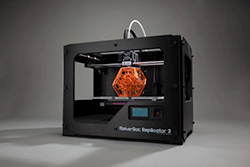
Gene Roddenberry introduced Star Trek fans to a device called a replicator in Star Trek: The Next Generation in 1987. Many will remember Captain Picard walking to a wall in his stateroom on the starship Enterprise and asking for “Tea, Earl Grey, hot.” The replicator would miraculously produce a steaming mug of tea out of thin air for the captain’s enjoyment.1 As the replicator was engaging the imaginations of science fiction fans in the late 1980s and early 1990s, scientists had already developed what could be a precursor to Starfleet’s replicator—the 3-D printer.
3-D printing, also referred to as additive manufacturing, is a rapidly evolving field of technology that allows users to take digital data from the web and turn it into complex physical objects with relatively inexpensive machines available for purchase at mainstream stores across the United States. The ability for the average person to easily manufacture a wide variety of objects at home, based on plans available over the Internet, could lead the world into a new industrial revolution, one that U.S. President Obama has said could “change the way we make everything.”2 This new technology can provide numerable benefits to society, including medical advances that could revolutionize wound care and organ transplants; reduction of food and medicine shortages around the world; more efficient production of everything from spare parts to houses and ships; and a reduced reliance on foreign labor and products.


